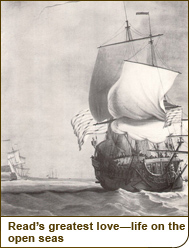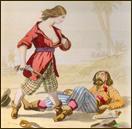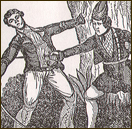

In the early eighteenth century, pirates scoured the Caribbean for plunder. Mary Read was as fierce as they came and is remembered as one of history’s most famous female pirates.
What drove a woman to choose the dangerous life of piracy? At a time when a single woman had few paths to take in life, Read’s choice of vocation offered her travel, adventure and a rare degree of autonomy. The greatest challenge she would face on the open seas was protecting herself from a shipload of seafaring scoundrels.
A Childhood Masquerade
The details of Read’s life remain steeped in pirate lore, with Captain Charles Johnson, her contemporary but a highly controversial chronicler, the only source claiming knowledge of her early years. According to Johnson, Read was born around 1685 in London to a widow who conceived her out of wedlock. The woman’s older son died soon after, and, in an attempt to gain financial support from her mother-in-law, Read’s mother dressed her daughter as a boy, passing her off as the older woman’s grandson. The ruse worked, and Read spent her childhood posing as a boy.
Read is said to have run away as a teenager on a British warship, eventually joining the Flemish Cavalry. None of this would have been possible for a teenage girl; Read’s ability to traipse around northern Europe was only possible because she was very convincing as a boy.
The act drew to a close when Read fell in love with one of her comrades-in-arms and was inspired to reveal her true sex. This portion of the story ends happily, with a wedding of the two soldiers; fellow officers even chipped in to buy Read’s first woman’s wardrobe.
The couple left military service and opened a tavern, but happiness proved to be fleeting. Read’s husband soon died of a fever, the couple’s business failed, and Read found herself in dire straits.
It’s a Man’s World
Playing to her strengths, Read reverted to wearing men’s clothing and joined the crew of a Dutch merchant vessel. Her ship was captured by the English pirate Charles Vane (the exact date is unknown), and, as the only English “man” on board, she was given the option of joining the crew. Read accepted and joined the pirates.
Life at sea was brutal: cramped quarters, minimum hygiene and death always lurking nearby. Keeping her male identity intact took great bravery and cunning. Read had to bind her chest with fabric to flatten her breasts, dress and tend to her feminine needs in secret and constantly train her body to be a match for any man. She lived as a pirate for several years (historical accounts vary from one to 17 years) before accepting King George’s amnesty for pirates in 1718.
She retired from the sea only briefly. When she was offered a job privateering, Read was quick to jump on board.
Read Finds Her Match
Each of them had a Machet[e] and Pistol in their hands, and cursed and swore at the men...—Dorothy Thomas, witness at the trial of Mary Read and Anne Bonny
Read’s career as a privateer was brief. Captain Johnson says she mutinied and returned to piracy; others say her ship was captured by the infamous pirates “Calico” Jack Rackham and Anne Bonny. However events transpired, Read was next seen alongside this piratical pair.
As the story goes, Bonny became infatuated with the young recruit (Read), forcing Read to reveal herself as a woman. There are many rumors, but no documentation, that there was a sexual relationship between the two women. It seems likely that they were nothing more than close friends and comrades-at-arms, but, like so much about them, this mystique persists.
Read’s next “coming out” is said to have been to Rackham, who had become suspicious that Bonny had taken a lover in the “boy.” (Read would have been in her thirties at this point, but women, with their lack of facial hair, generally passed as boys rather than as full-grown men.) Once her identity was revealed to the captain, it seems that Read discarded the ruse, as a pair of Frenchmen testifying at the trial of Read and Bonny specifically said that the two women sometimes dressed in men’s clothes and other times in women’s.  Whatever the outfit, the “fierce hellcats” Bonny and Read proved to be as deadly as any aboard Rackham’s ship.
Whatever the outfit, the “fierce hellcats” Bonny and Read proved to be as deadly as any aboard Rackham’s ship.
In October 1720, the British naval captain Jonathan Barnet attacked Rackham’s ship while it was anchored off Jamaica. The male pirates, drunk below deck, left Read and Bonny to defend them. Read reportedly shouted down into the hold, demanding that the others emerge and fight like men. When they didn’t emerge, she fired her guns into the hold, killing one of her own crew and wounding two. It took over an hour for Barnet and his men to subdue the women and the few drunken men who woke up to assist them. Eventually, the ship was overtaken, and the defeated crew was sent to Jamaica to stand trial.
Belly of the Pirate
In St. Jago de la Vega, Jamaica, on November 28, 1720, Read and Bonny were convicted of “piracies, felonies and robberies ... on the high sea.” Eyewitnesses claimed that both women fought as fiercely as the male pirates.
Rackham and his men were hanged. Read and Bonny were given the same sentence, but “informed the court that they were both quick with child.” British law forbade execution of pregnant women, as their babies were viewed as innocent victims. To ask for pardon in such a case was known as “pleading the belly,” and Read and Bonny successfully did so. The court records show that an examination was ordered. Since neither woman was hanged, it appears that their claims were validated. One possible explanation is that the women made a deal with the doctor. Such a ruse, however, would have had limited currency, so the fortuitous coincidence of simultaneous pregnancies may well have been true.
What is known is that Read died on April 28, 1721, in the town where she was imprisoned, and Captain Johnson records that she died of fever while still in jail.  If she was not obviously pregnant on the date of her trial, but the baby’s motion could be felt, one could make a fairly accurate guess as to the date her pregnancy. A quick calculation of months suggests that she died within a week of her due date. If she died of fever, it is quite possible that she died from sepsis, a condition that afflicted women after giving birth in unsanitary conditions such as may have existed in her prison cell. The burial record at the church where she was buried lists “Mary Read, pirate,” as well as many other people, including babies, who died about the same time. Had Read’s baby died with her, it would have been listed. It appears that although her illustrious existence ended in a filthy prison cell, at least one descendant of this remarkable woman survived.
If she was not obviously pregnant on the date of her trial, but the baby’s motion could be felt, one could make a fairly accurate guess as to the date her pregnancy. A quick calculation of months suggests that she died within a week of her due date. If she died of fever, it is quite possible that she died from sepsis, a condition that afflicted women after giving birth in unsanitary conditions such as may have existed in her prison cell. The burial record at the church where she was buried lists “Mary Read, pirate,” as well as many other people, including babies, who died about the same time. Had Read’s baby died with her, it would have been listed. It appears that although her illustrious existence ended in a filthy prison cell, at least one descendant of this remarkable woman survived.
Amidst all the ambiguity, mystery and folklore, one thing eyewitnesses agree on is that Read’s greatest love was living as a pirate. Dressed as a man or a woman, Read brandished cutlass and pistol with gusto and thrived in a life not generally open to women.
:: woa.tv staff
Mary Read Selected Sources







